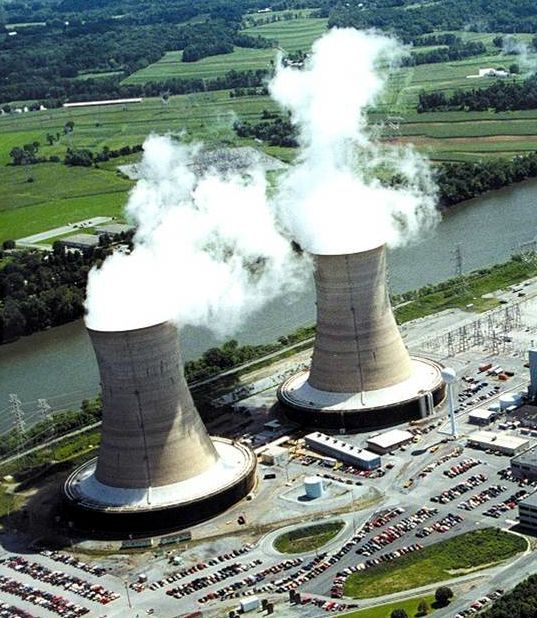Water Cooling Towers |

Three Mile Island Cooling Towers (Courtesy of Russ Green , TMI)
Open recirculated cooling water systems remove the heat picked up in plant by evaporative cooling. This may be done by a spray pond, for example, combining air conditioning needs with aesthetic considerations in industrial parks. The most common type of evaporative cooling, however, is effected in cooling towers of one type or another (reference). Cooling towers may operate on natural draft, as in the case of wind-cooled towers for small home air conditioning systems or the large concrete hyperbolic towers used in power generating stations as shown above. In process plants, the towers are more often aided by fans, either forced or induced draft operations, to improve the cooling capacity. There are certain fundamental considerations which should be understood in relation to open recirculated systems.
Foremost is the concept of cycles of CONCENTRATION. If three cups of boiling water in a tea kettle were allowed to boil away to one cup, the residual cup would contain a three-fold concentration of soluble water salts, assuming that only steam (i.e., pure water) was driven off. The water would be said to be at three cycles of concentration. To prevent this accumulation from becoming unacceptable from the standpoint of scale and corrosion, a small amount of blowdown (bleeding of the system) is maintained to control the number of cycles of concentration from evaporation. This means that makeup water must be added to equal the evaporation and blow-down losses, but this is a minor amount compared to the volume of the total system.
For example, if 19,000 Lpm of cooling water are needed in a system, the cost for treatment in a once-through design would be excessive. However, in a recirculating system, the makeup may only be 380 Lpm, of which only 95 Lpm may need to be treated with inhibitors. This brings chemical treatment into the range of economic feasibility, as compared with a once-through system.
See also: Calcium carbonate, Carbon dioxide, Chlorination, Dissolved oxygen, Langelier calculation, Langelier index, Larson-Skold index, Oddo-Tomson index, pH, Puckorius index, Ryznar index, Scaling Indices, Stiff-Davis index, Total dissolved solids, Water corrosivity,
 |